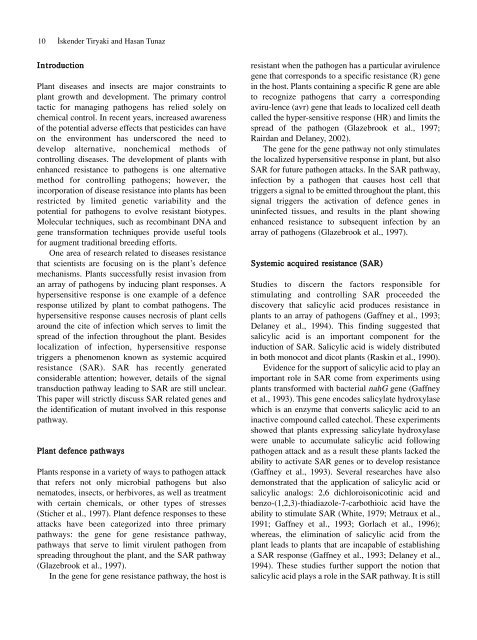Full Journal - Journal of Cell and Molecular Biology - Haliç Üniversitesi
Full Journal - Journal of Cell and Molecular Biology - Haliç Üniversitesi
Full Journal - Journal of Cell and Molecular Biology - Haliç Üniversitesi
Create successful ePaper yourself
Turn your PDF publications into a flip-book with our unique Google optimized e-Paper software.
10 ‹skender Tiryaki <strong>and</strong> Hasan Tunaz<br />
Introduction<br />
Plant diseases <strong>and</strong> insects are major constraints to<br />
plant growth <strong>and</strong> development. The primary control<br />
tactic for managing pathogens has relied solely on<br />
chemical control. In recent years, increased awareness<br />
<strong>of</strong> the potential adverse effects that pesticides can have<br />
on the environment has underscored the need to<br />
develop alternative, nonchemical methods <strong>of</strong><br />
controlling diseases. The development <strong>of</strong> plants with<br />
enhanced resistance to pathogens is one alternative<br />
method for controlling pathogens; however, the<br />
incorporation <strong>of</strong> disease resistance into plants has been<br />
restricted by limited genetic variability <strong>and</strong> the<br />
potential for pathogens to evolve resistant biotypes.<br />
<strong>Molecular</strong> techniques, such as recombinant DNA <strong>and</strong><br />
gene transformation techniques provide useful tools<br />
for augment traditional breeding efforts.<br />
One area <strong>of</strong> research related to diseases resistance<br />
that scientists are focusing on is the plant’s defence<br />
mechanisms. Plants successfully resist invasion from<br />
an array <strong>of</strong> pathogens by inducing plant responses. A<br />
hypersensitive response is one example <strong>of</strong> a defence<br />
response utilized by plant to combat pathogens. The<br />
hypersensitive response causes necrosis <strong>of</strong> plant cells<br />
around the cite <strong>of</strong> infection which serves to limit the<br />
spread <strong>of</strong> the infection throughout the plant. Besides<br />
localization <strong>of</strong> infection, hypersensitive response<br />
triggers a phenomenon known as systemic acquired<br />
resistance (SAR). SAR has recently generated<br />
considerable attention; however, details <strong>of</strong> the signal<br />
transduction pathway leading to SAR are still unclear.<br />
This paper will strictly discuss SAR related genes <strong>and</strong><br />
the identification <strong>of</strong> mutant involved in this response<br />
pathway.<br />
Plant defence pathways<br />
Plants response in a variety <strong>of</strong> ways to pathogen attack<br />
that refers not only microbial pathogens but also<br />
nematodes, insects, or herbivores, as well as treatment<br />
with certain chemicals, or other types <strong>of</strong> stresses<br />
(Sticher et al., 1997). Plant defence responses to these<br />
attacks have been categorized into three primary<br />
pathways: the gene for gene resistance pathway,<br />
pathways that serve to limit virulent pathogen from<br />
spreading throughout the plant, <strong>and</strong> the SAR pathway<br />
(Glazebrook et al., 1997).<br />
In the gene for gene resistance pathway, the host is<br />
resistant when the pathogen has a particular avirulence<br />
gene that corresponds to a specific resistance (R) gene<br />
in the host. Plants containing a specific R gene are able<br />
to recognize pathogens that carry a corresponding<br />
aviru-lence (avr) gene that leads to localized cell death<br />
called the hyper-sensitive response (HR) <strong>and</strong> limits the<br />
spread <strong>of</strong> the pathogen (Glazebrook et al., 1997;<br />
Rairdan <strong>and</strong> Delaney, 2002).<br />
The gene for the gene pathway not only stimulates<br />
the localized hypersensitive response in plant, but also<br />
SAR for future pathogen attacks. In the SAR pathway,<br />
infection by a pathogen that causes host cell that<br />
triggers a signal to be emitted throughout the plant, this<br />
signal triggers the activation <strong>of</strong> defence genes in<br />
uninfected tissues, <strong>and</strong> results in the plant showing<br />
enhanced resistance to subsequent infection by an<br />
array <strong>of</strong> pathogens (Glazebrook et al., 1997).<br />
Systemic acquired resistance (SAR)<br />
Studies to discern the factors responsible for<br />
stimulating <strong>and</strong> controlling SAR proceeded the<br />
discovery that salicylic acid produces resistance in<br />
plants to an array <strong>of</strong> pathogens (Gaffney et al., 1993;<br />
Delaney et al., 1994). This finding suggested that<br />
salicylic acid is an important component for the<br />
induction <strong>of</strong> SAR. Salicylic acid is widely distributed<br />
in both monocot <strong>and</strong> dicot plants (Raskin et al., 1990).<br />
Evidence for the support <strong>of</strong> salicylic acid to play an<br />
important role in SAR come from experiments using<br />
plants transformed with bacterial nahG gene (Gaffney<br />
et al., 1993). This gene encodes salicylate hydroxylase<br />
which is an enzyme that converts salicylic acid to an<br />
inactive compound called catechol. These experiments<br />
showed that plants expressing salicylate hydroxylase<br />
were unable to accumulate salicylic acid following<br />
pathogen attack <strong>and</strong> as a result these plants lacked the<br />
ability to activate SAR genes or to develop resistance<br />
(Gaffney et al., 1993). Several researches have also<br />
demonstrated that the application <strong>of</strong> salicylic acid or<br />
salicylic analogs: 2,6 dichloroisonicotinic acid <strong>and</strong><br />
benzo-(1,2,3)-thiadiazole-7-carbothioic acid have the<br />
ability to stimulate SAR (White, 1979; Metraux et al.,<br />
1991; Gaffney et al., 1993; Gorlach et al., 1996);<br />
whereas, the elimination <strong>of</strong> salicylic acid from the<br />
plant leads to plants that are incapable <strong>of</strong> establishing<br />
a SAR response (Gaffney et al., 1993; Delaney et al.,<br />
1994). These studies further support the notion that<br />
salicylic acid plays a role in the SAR pathway. It is still
















